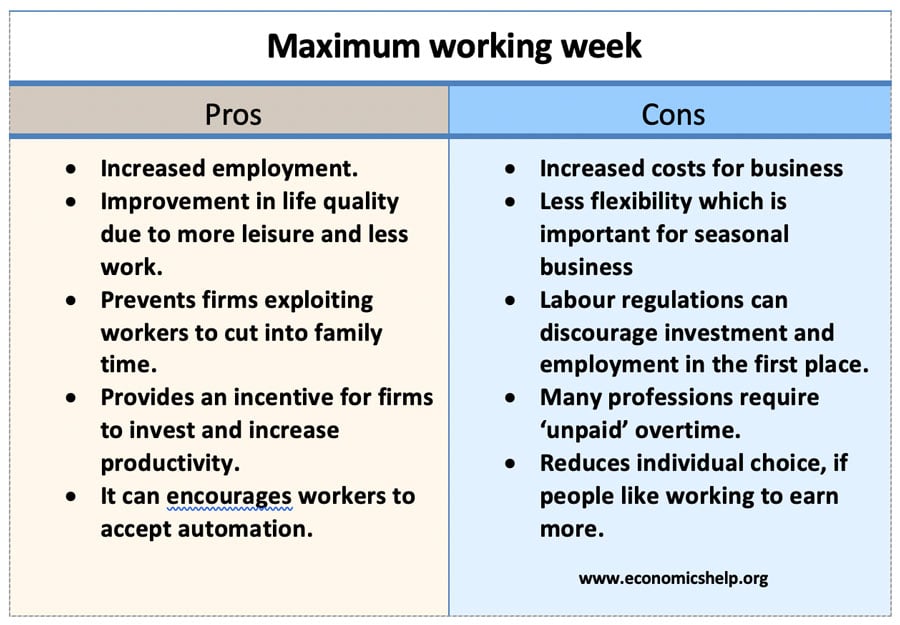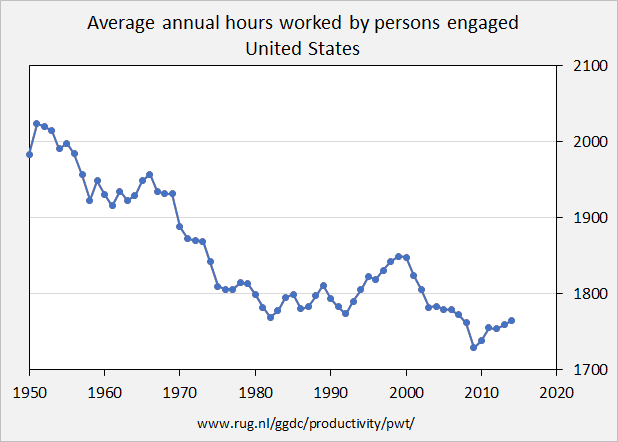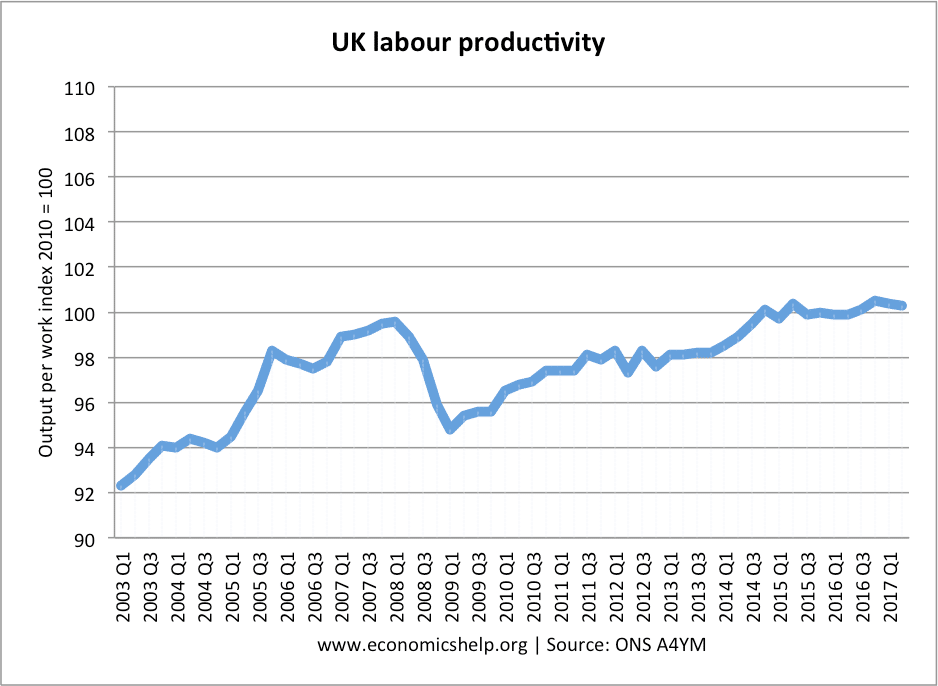A maximum working week is a legal limit on the standard number of hours that can be worked in a week. For example, in 2000 France passed a maximum working week of 35 hours. Additional hours could be worked, but they had to be paid at an overtime rate of +25%.
At the 2019 Labour Party Conference, the shadow chancellor John McDonnell proposed a maximum working week of 32 hours – within ten years. However, it is worth noting this plan did not set a legal limit – but an aspiration to negotiate lower hours without any real pay cut. The main plan is to leave the opt-out of the European Working Time Directive and for working hours to be included in legally-binding sectoral agreements,
The European Working Time Directive has a maximum working week of 48 hours. Britain currently has an opt-out so employers can ask workers to work more.

Arguments for a maximum working week
Lower unemployment. A motivation for the French law of a 35-hour maximum working week was the hope it would reduce unemployment. In 2000, France had an unemployment rate of 12.5%. The logic is that if a firm cuts the hours of workers, there will be a necessity to increase the number employed to make up for the fewer hours worked by each worker. A firm will find it more cost-effective to employ a new worker than pay overtime.
- However, this assumes that the firm will be able to hire equally skilled and suitable workers. In practice, firms find it difficult to exactly replace a worker who knows the job well.
- The other logic of a maximum working week is that an employer will maintain the same wage – despite lower hours; therefore, to afford this increase in real pay, there is an incentive to increase productivity – set higher output targets so the firm can get the same output from fewer workers. If productivity does rise to match the hour cut, there will be no need to employ more workers.
- In July 2017, Unemployment in France was 9.7% – so the economy is still suffering relatively high unemployment.
Non-monetary goals. An argument for a maximum working week is that it enables more leisure time and reduces work-related stress. Therefore a maximum working week helps to increase the quality of life – factors not measured by traditional economic indices, such as GDP and average wages. A legally binding 48-hour max working week helps prevent getting burnt out and preventing work overtaking people’s lives.

A diagram showing fall in hours worked in US. Penn Table of the University of Groningen Growth and Development Centre. CC BY-SA 4.0 by
Long-term trend. There has been a long-term trend in reducing hours worked. In the late nineteenth century, in the US it was estimated the average working week was 60 hours per week. In the UK in the mid-nineteenth century, a factory worker in the UK could work up to 16 hours a day, six days a week. Improvements in productivity and better technology have all enabled hours to fall and real wages to rise. However, this trend in falling hours stalled in the 1980s.
It is interesting to note that in 1930, John Maynard Keynes predicted a time when the working week would be cut to 15 hours a week. Keynes argued rising living standards would cause people to choose less work and more leisure time. (Note Keynes wasn’t advocating a legal maximum working week. He argued it would occur by free-market forces)
Productivity deals. One way to enable a cut in hours without cutting pay is for unions and employers to agree to a deal which brings in new working practises and technology. For example, The Royal Mail and the CWU union have negotiated a deal which aims to bring in the automation of production to cut workers’ hours from 39 hours a week to 35 hours without a reduction in pay. (link)
Arguments against maximum working week
Increased cost for business. Firms may need to pay overtime during busy times of production when workers cannot easily be substituted. Also, if they employ more workers, there is the cost of hiring and training workers to take on the extra work.
Productivity can be difficult to increase. Some sectors may be able to use new technology such as AI and automation, but for other sectors it is difficult. For example, nursing, caring and waitress service – all would struggle to increase productivity by 10 or 20%. These sectors may not be able to cut hours of workers and maintain real pay, and this would make business unprofitable.

In the past few years, productivity growth has stalled around the world and the UK in particular. This stall in productivity growth is one reason to explain why we have not seen falling hourly weeks. Government legislation to promote the maximum working week, does not on its own boost productivity. Some business argue maximum working regulations put the ‘cart before the horse’. In other words, it is productivity growth that fuels reductions in working weeks and not the other way around. The historic fall in hourly working weeks has generally not been achieved by government regulations.
Hard to count hours in many professions. For many professions, it is harder to measures hours worked. For example, teachers may have 30 hours of contact time, but to complete their job satisfactorily, they may need to work an extra 15-20 hours to finish marking and preparation. It is harder to legislate for this kind of ‘unpaid’ overtime. In France, it is a myth to think most people work 35 hours a week.
Ways around legislation. People may find ways around legislation. For example, the maximum working week led to an increase in people working in the gig economy or people working at two jobs. A maximum working week has no effect on the increasing numbers of self-employed in the gig economy.
Over regulated labour markets discourage investment. Critics of maximum working weeks argue that costly legislation can be a discouragement to firms to set up business and invest in the first place. For example, firms may outsource call centres to developing countries to get around maximum working week.
Individual choice. Some workers may enjoy working and not appreciate being forced to work less.
Conclusion
It is an interesting topic. Average hours worked fell from 60 hours to 40 hours during the Twentieth Century. But, how much would workers value a four day week. Do we know what to do with our leisure time? The bigger question is whether government regulation can enable the productivity gains to enable lower hours and higher real pay. The likelihood is that some sectors of the economy can, but others will not be able to implement sufficient productivity gains.

How does the government accumulate foreign currency reserves when private firms export goods?